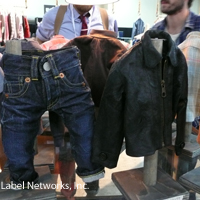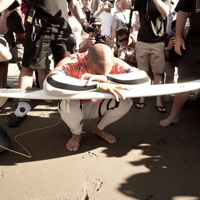It came as no surprise when Volcom announced on Tuesday, September 2, 2008 that it would be buying it’s Japanese distributor of 15 years. It’s clearly the best way to target more effectively what can be a complex market, yet vital one for such a brand.
According to Volcom’s announcement, Richard Woolcott, chairman and chief executive officer stated, “This acquisition is a testament to the strength of our brand in Japan after working with our distributor for more than 15 years. We are excited to culminate a longstanding relationship with an opportunity to work more closely with our accounts in this important territory, while retaining our Japan-based distribution team.
“Acquiring our Japanese distributor is part of Volcom’s international growth strategy, and we look forward to further enhancing our presence throughout Japan,” Woolcott continued.
What’s interesting is that Volcom is taking a more targeted interest in what could very likely be their next cash-cow market -and possibly more so than Europe, not to mention the run-off into South Korea, Tawain, and China. However street fashion in Japan is decidedly different than in the USA. Taking excerpts from a flashback story Label Networks actually wrote for Bread & Butter Bulletin Magazine, here’s some insight on the Japanese streetwear scene:
It’s no secret that Japan, Tokyo area in particular, is known for its off-the-wall fashion. Mix of colors, patterns, more accessories than you have ever seen and their attention to detail is enough to make you wonder if the youth in Japan were predisposed to future fashion know-how years before the rest of us. But why?
In a society that is full of conformity and private education seems to be the norm, a backlash of “after school” fashion sets Japan apart from the rest. And even after 13 years of education, all years in a required school uniform, 18-22 year old young men and women move onto “recruit suits”, standard work wear that is what most consider an extension of their high school uniform.
So wouldn’t this allow for bland fashion taste and mild choices in weekend wear? Quite the opposite. It’s an anything goes attitude that allows brands to dip back to the ’80’s, completely clean-out American thrift store shelves (flannels, used, faded, torn jeans, layers and layers of tanks, shirts, button-ups), use crazy colors and even crazier fabrics. It’s almost a group influenced form of individuality where you will see someone dressed in a multiple of layers such as black knee-high leather boots, black and white striped leggings, jean shorts, purple tank top, black vest, green off-the-shoulder knit sweater and a jean jacket, swamped with pins and patches of all their favorite bands.
Streetwear trends in Japan move at lightening speed, and there is a clear new sense of importance that’s been placed on “urbanwear” (not be confused with the American version of urbanwear but more of the European sensibility meaning metropolitan-chic) among the most fashionable, including a high-volume of girls now wearing denim. There’s also a great deal of attention globally to top Japanese urbanwear designers. Japan however can be extremely confusing when it comes to streetwear. It is the ultimate mash-up of street couture, so copied and reassembled as to appear original, which to many people appears non-directional. In a society packed in a neon urban landscape, on the fringes of tradition and group individuality, it’s actually completely directional depending on what street you’re on. Think of a square: Each side and right angle has something completely different than the other. As a whole, the person, the personae, the block of fashion, may seem haphazard, but it’s not really when you know what each side contained to begin with. Assembling individual sides together that purposely seem to be dysfunctional but actually all work together is the real genius of Japanese streetwear fashion. It’s the re-seen. Hints of d%uFFFDj%uFFFD vu but new based on how it’s all put back together and slightly altered.
Such rebellious urbanism in street fashion’s evolution can clearly be seen with designers such as Junya Watanabe and Rei Kawakubo from the Comme des Garcons household. Watanabe has a militant streetwear style and has gained favor with some of the most hardcore trendsetters in urbanwear. Specifically, his interpretations of militarism, tailored camo, cropped parkas that look like a bubble-bottom jacket, cropped pants, duct-taped balaclavas, and almost punk rock usage of studs and spikes have pushed across boundaries. His street suit jacket with camo pockets are another crossover. His particular military vibe smartens-up existing looks.
Jun Takahashi’s Undercover label made waves with hooded figures when showing his collection 2 season’s ago providing a scary yet edgy look that actually did seem removed from the youth street culture of Harajuku who are so engrossed in latest big-wave hairstyles. However Undercover’s camo, cloaks, and cropped pants were also street without the denim -instead using deconstructed parkas or wool coats and pants. Highly regarded among designers such as Jeffrey Sebelia from America who has a similar sense of punk urban militarism streetwear style, Undercover has pushed boundaries: Where Sebelia sometimes uses newspaper in deconstructed urbanwear, even dresses, Undercover has produced reconstructed T-shirts to create complex dresses and tunics. Both have used leather leg coverings with pieces of metal, spikes, and buckles to complete looks, providing a futuristic accomplishment of where things are headed in urbanwear moving beyond the current version of upper urbanwear styles as we know them to be today.
Visvim, the Japanese anti-sneaker sneaker continues to make waves in upper urbanwear footwear. Coverage of Visvim designs, now also in apparel, just plague insider sneaker-freaker websites like Hypebeast, Kick-fiend, and Beinghunted. As Hiroki Nakamura, the creative director of Visvim once stated, shoes are our daily tools. They must be functional, comfortable, durable, and fashionable. Visvim however, like many designers pushing the leading-edge, can be a lightening rod -people tend to either love them or hate them.
While North America, Europe, and Japan all have their versions of streetwear ore street fashion and now upper urbanwear trends, including their own designers and collaborations, the fastest growing market pushing the evolution are individuals themselves, and this often takes place in Japan -those who simply make their own streetwear fashion out of a variety of sources, including a range of high-end pieces mixed with inexpensive but personally chic strategies. These people, the unknown style-sensitives of street couture often have no aspirations to become the next Junya Watanabe or Jeffrey Sebelia, but simply gain inspiration from their surroundings and enjoy their own sense of individuality and expression through fashion. Getting outside, walking the urban landscape, and seeing such people in their own local regions, is the best source of knowing where things are headed in the evolution of streetwear. These people are the real crop of new leaders pushing trends in the quiet underground. It’s through their personal sense of style that gets the rest of us to take notice, and quite honestly, follow.
For more information on Label Networks’ Japan Youth Culture Study or Profile Reports, email info@labelnetworks.com; (323) 630-4000.


